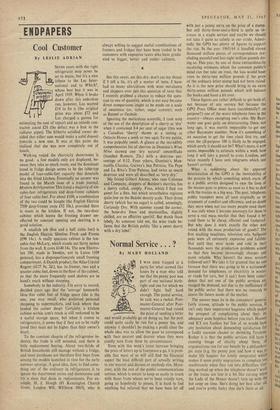ENDPAPERS
Cool Customer
By LESLIE ADRIAN
SEVEN years with the right refrigerator may never be
set to music, but it's a nice
tribute to the Lec Inter- national and to Which?,
whose best buy it was in April 1959. When it broke down after this unbroken run, however, Lec wanted £14 to fix it (the original price was about £72 and Lec charged a guinea for estimating the cost of repair) and an outside con- tractor asked £26 (the defect was a leak in the radiator pipes). The hitherto satisfied owner de- cided that either sum would make a solid deposit towards a new one. It was at this point she realised that she was now completely out of touch..
Walking round the electricity, showrooms is no good: a few models only are displayed, be- cause they take so much room, and the dominant trend in fridge design seems to be the table-top model of four-cubic-feet capacity that dovetails into the fitted kitchen. Eventually an answer was found in the March issue of a trade journal, Modern Ref rigeration.This listed a Majority of six- cubic-feet refrigerators and deep-freeze cabinets of four cubic feet. For about £100, a combination of the two could be bought (the English Electric 7200 deep-freezer costs £52 10s.), provided there is room in the kitchen. If not, the two-door cabinet which leaves the freezing drawer un- affected by constant opening and shutting is a good solution.
A smallish job (five and a half cubic feet) is the. English Electric Slimline Fresh and Freeze (E98 14s.). A really spacious cabinet is the ten- cubic-feet McLary, which stands out thirty inches from the. wall. It costs £140 14s. The new Electro- lux 100, made in Sweden, not in Luton (109 guineas), has a disproportionately small freezing compartment. A Danish product, the Atlas Crystal Regent (£127 9s. 2d.), has its freezer, two and a quarter cubic feet, down in the floor of the cabinet, So that the more frequently used shelves are in hand's reach without stooping.
Somebody in the industry, I'm sorry to record, decided years ago that the 'average' housewife likes five cubic feet of fridge space (she is the one, you may recall, who preferred personal shopping to supermarkets, and look where that landed the corner shop). Certainly, a kitchen Cabinet within arm's reach is still reckoned to be a useful storage space, but when it comes to refrigerators, it seems that if they are to be really loved they must not be higher than their owner's heart.
To the constant chagrin of the refrigerator in- dustry, the trade is still seasonal, and there is little replacement buying. About two-thirds of British households still manage without a fridge, and most purchases are therefore first buys from among the models launched in time for the early summer upsurge. A good idea, then, to find some- thing out of the ordinary in refrigerators is to ignore the department stores and showrooms and try a shop that deals in replacements. For ex- ample, H. J. Hough (81 Kensington Church Street, London W8; WEStern 3065), who is always willing to suggest useful combinations of freezers and fridges that have been traded in by customers with expensive tastes who have gradu- ated to bigger, better and colder cabinets.
See this sweet, see this dry, don't cut my throat if I tell a lie, it's all a matter of taste. I have had so many altercations with wine merchants' and shippers over just this question of taste that I recently grabbed a chance to reduce the ques- tion to one of quantity, which is not easy because direct comparisons ought to be made on a scale of sweetness (or, rather, sugar content), such as Baume or Oechsle.
Ignoring the meticulous scientific, I took note of the use of the description of a sherry as `dry' when it contained 3-4 per cent of sugar (this was a Canadian 'sherry' shown at a tasting at Ontario House a week or two ago). To my palate, it was palpably sweet. A glance at the incredibly comprehensive list of'sherries in Dominic's Wine Mine showed one 'dry natural' amontillado (Sanchez Romate, 22s.) with a dextrose per- centage of 0.12. Four others, Dominic's Man- zanilla•Classica, Garvey's San Patricio, Tio Pepe and La Riva's Tres Palmas, had twice as much dextrose and were all described as 'very dry.'
My friend Gilbert Aikens, who runs Coleman and Company, shippers of Burdon's sherries, has a sherry called, simply, Fino, which I find too tweet for a fino, but which nevertheless registers quite low on the Baume density scale. Their driest sherry (which has no sugar) is called, amusingly, Curiously Dry. With summer round the corner, the bone-dry linos and manzanillas, slightly chilled, are an effective aperitif. But watch those labels: As someone told me, the wine trade be- lieves that the British public 'like a sweet sherry with a dry label.'






























 Previous page
Previous page